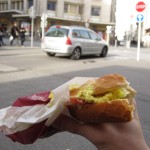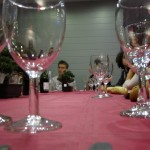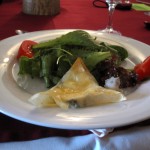According to Jesus, man cannot live on bread alone. I reject this statement for two reasons. First, it ignores half of the human population. Second, this man can. I have always been a bread addict, and I always knew how much I would love the breads here in France. However, the artistry of French cuisine is showcased by, not limited to, bread.
While writing this post, I happened across an interesting NPR article. Apparently, France is McDonald’s number 2 market after the United States. Wait, so France likes fast food? Well, not as we know it. According to author Eleanor Beardsley, McDonald’s was able to survive because they radically adapted to the eating expectations of France. The McDonald’s France experience delivers slower, better, realer (all beef in France is grass-fed, tracked from birth to slaughter, and free of added hormones) food. In the United States, we worship what is quick and easy, so McDonald’s USA is not so great. But in France, food is a religion, and in order to win over the French, McDonald’s had to adopt a different gospel. Here is a quick guide to eating in France:
Breakfast (petit déjeuner) is small. Take your time, and don’t worry about when you get down to eat: breakfast is not necessarily taken together. You will have to make some choices, because there will be multiple breads and spreads laid out on the table. The croissants are flaky, buttery, and light in the hands as you tear off a bite and begin to eat. There is also Brioche, which I like to describe as breakfast cake—heavier, and sweeter than a croissant. Then there is pain-au-chocolate, a bit like a croissant, but with a thin line of chocolate running through the center. It is not uncommon to have some of last night’s dessert as an option, as well as yogurt, coffee, and perhaps a clementine. Don’t panic. This is only breakfast.
Lunch (déjeuner) is a little more social of a meal. Often, it revolves around a sandwich crafted from subtle layers of meats and cheeses, goat cheese being my preference for its delicate strength. Yet, do not be surprised by more daring mixes, such as the curry chicken baguette I had last week; it is often hard for me to actually describe what French food is, because they like so many things, as long as they’re good. If you don’t have the ingredients for a sandwich, there is no need for concern. I doubt there are any geographic coordinates in Nantes that are not within a 5 minute walk from somewhere that sells sandwiches.
Supper/diner (dîner) is a long time coming, and a long time lasting. My host family usually eats around 19h30, or 7:30, but 8:00 or 9:00 are not unheard of either. There will be bread on the table, and perhaps a bottle of wine, but WAIT! Do not begin to eat your bread until the food arrives. It is part of the meal, not an appetizer. Also, do not drink or even pour the wine until the food arrives, for the same reason. When it does, women are served first.
Now that the food has arrived, you may take up your bread, and have a drink. Do not hold the bread to your face and bite like a cave person! Take it from the table—it does not go on the plate—and rip from it the morsel you wish to eat. Notice the crust and its tender contents. Before pouring yourself a drink, be sure that those around you have full glasses. Feel free to begin your salad or soup. If it is a soup, it will likely be rich with butter, and you will not require much.
The soup or salad finished, the main course will arrive. It might be duck, or salmon, or chicken, or beef, but it will mostly likely not be vegetarian. They don’t really understand that. The fork and knife are usually used in the dominant and non-dominant hand, respectively. Handle nothing but the bread and the silverware with your hands, including things like pizza. There was only one time I used my hands for something other than the bread. It was at home, and we were having duck, which was quite delicious. Unfortunately, I took a segment whose bits of meat were in precisely the right places so as to be completely inaccessible by fork and knife. After some struggling, I was granted permission to use my hands. But don’t tell anyone.
You will always end on dessert. It might be a delicate mousse, or a small cake with ice cream on top. You may be served crêpes covered with butter and sugar, deadly delicious, and best simple (chocolate would distract from the crêpe itself). You might have some yogurt with caramel drizzled on it. Whatever it is, the French always have dessert.
It’s a good thing we walk a lot here, because sometimes, it all tastes like dessert.
- A breakfast spread this morning.
- My chicken curry baguette.
- We were still waiting on the food, so the bread was on the table, and the glasses were empty.
- A salad with a little square of goat cheese hidden away in that triangular…thing.
- This was a delicious, rich soup of squash, butter, and probably more butter.
- This was my first time eating duck (not the time I couldn’t get at the meat), and this dish was one of the most delicious things I’ve ever eaten.
- We found a really wonderful creperie in central Nantes. This is my second time there.






